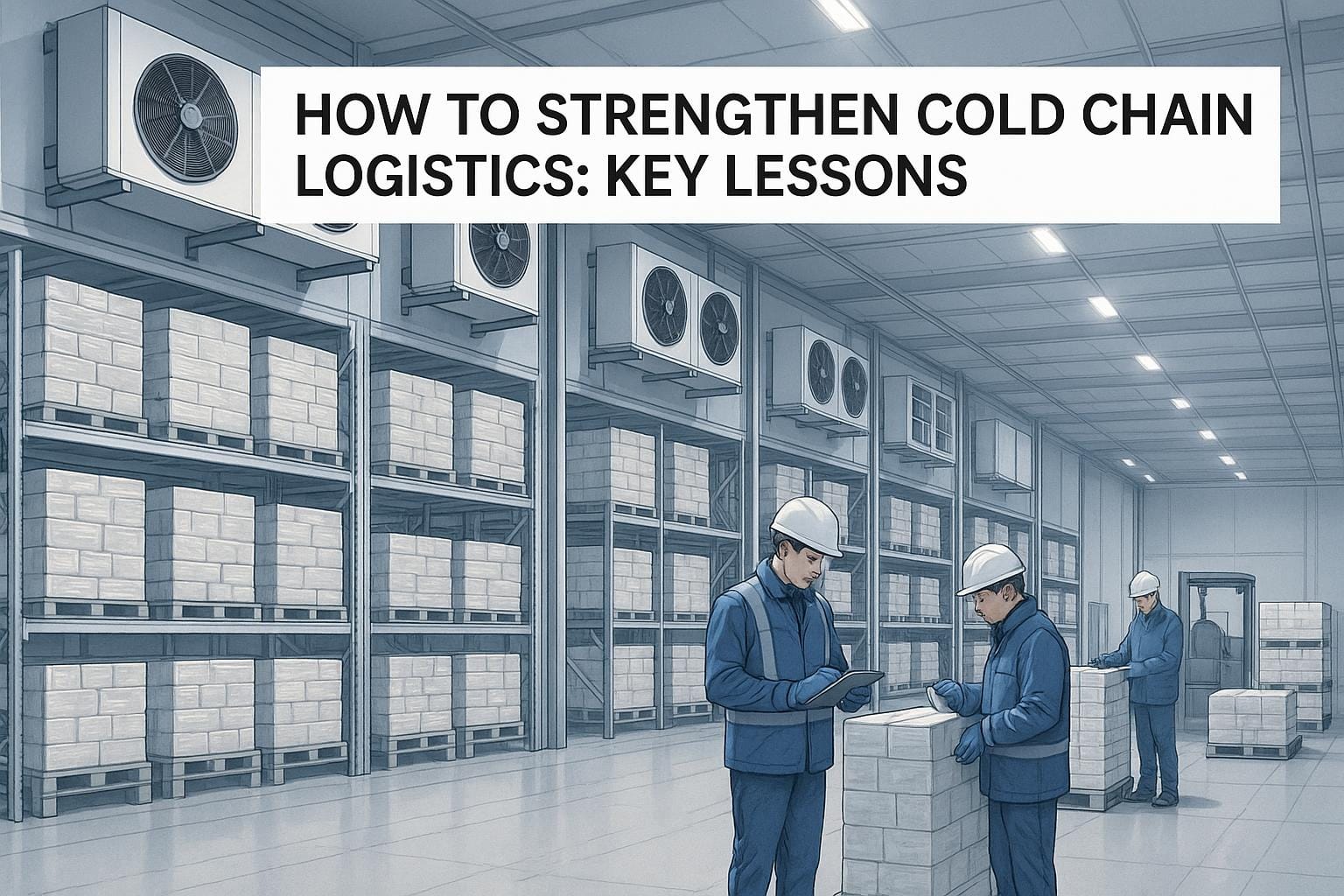How to Strengthen Cold Chain Logistics: Key Lessons
Discover key insights into cold chain logistics, including best practices for handling perishable goods and improving supply chain efficiency.

The cold chain logistics sector has undergone a remarkable transformation over the past few decades, evolving from a rudimentary system of trust-based operations to a sophisticated, technology-driven network capable of supporting global perishable goods distribution. In a candid and insightful discussion, industry veteran Raul Asencio shared his experiences and lessons learned, spanning his decades-long career across fish exports, fresh produce transportation, and cold chain innovation. This article extracts the key takeaways for enterprise and government leaders in the GCC logistics, warehousing, and infrastructure sectors, with a spotlight on the critical role of cold chains in ensuring quality, compliance, and competitiveness.
The Evolution of Cold Chain Logistics
A Humble Beginning
Raul Asencio’s career began in the 1970s in Manta, Ecuador - a city known as a global hub for tuna fishing. At the time, cold chain processes were rudimentary at best. Fish was caught, packed in basic wooden crates, and transported with ice to maintain freshness, but the process was highly dependent on manual oversight and trust between buyers and sellers. This era was marked by a lack of traceability, technological standardisation, and quality assurance tools.
The Transformation of Packaging
One of the most tangible evolutions in cold chain logistics, according to Asencio, has been the advancement in packaging. From large, leaky wooden crates to dense, waxed cardboard boxes with gel packs, packaging today plays a pivotal role in preserving product quality. Pre-conditioning packaging materials - ensuring boxes are chilled before use - is a vital yet often overlooked practice that can significantly enhance product lifespan and reduce spoilage.
This seemingly minor change has had implications far beyond logistics, influencing everything from airline cooperation to compliance with international regulations for transporting perishable goods like pharmaceuticals and seafood.
Traceability Through Technology
Advancements in traceability, such as the adoption of RFID tags and other temperature-monitoring devices, have further revolutionised the industry. Asencio highlights how these tools have allowed logistics providers to identify and mitigate "temperature excursions", such as breaks in the cold chain caused by airport delays, poor warehouse conditions, or improper handling during transit.
By addressing these gaps, businesses can ensure better quality control, extend product shelf life, and foster trust among producers, distributors, and consumers - a critical factor in competitive markets with tight compliance standards like the GCC.
Core Insights from Cold Chain Challenges
1. Temperature Control Is Everything
Whether transporting fish from South America or asparagus from Peru, maintaining the proper temperature throughout the supply chain is the cornerstone of successful cold chain management. Temperature-sensitive goods like fruits, vegetables, flowers, and pharmaceuticals are particularly vulnerable to quality degradation if exposed to even brief periods of suboptimal conditions.
Asencio’s advice for companies handling perishable goods is clear: design infrastructure and processes that prioritise temperature optimisation at every stage.
- Use varying temperature chambers for different categories of goods (e.g., 34–38°F for berries versus 55–60°F for tropical fruits).
- Invest in rapid cooling systems to quickly restore optimal conditions after deliberate or accidental breaks in the cold chain, such as fumigation processes for imported asparagus.
2. Pre-Conditioning Packaging
A pivotal insight shared by Asencio is the importance of ensuring that packaging materials themselves are adequately chilled before use. Whether dealing with pharmaceuticals or seafood, a pre-conditioned box reduces the risk of temperature fluctuation during transit, which can compromise product quality.
This concept, once overlooked even by major pharmaceutical firms, is now a best practice across multiple industries.
3. Adaptable Infrastructure
Asencio emphasises the importance of designing adaptable infrastructure that can handle a diverse mix of temperature-sensitive products. His tenure at Helmann Worldwide Logistics saw the transition from a single, general-purpose warehouse to a state-of-the-art facility with specialised chambers for seafood, flowers, berries, and more. This move allowed the company to cater to a broader clientele while ensuring optimal storage conditions for every product type.
For GCC government and enterprise stakeholders, this insight underscores the necessity of investing in modern facilities that can support diverse sectors, from pharmaceuticals to agriculture.
Building Trust in the Modern Supply Chain
The Role of Relationships
Despite technological advancements, Asencio underscores the enduring importance of relationships in the cold chain industry. For decades, producers relied on trusted logistics providers to ensure their goods arrived at their final destinations in pristine condition. While technology has reduced dependency on personal trust, the human factor remains critical, especially for small-to-medium-sized producers.
Big Data and Transparency
Technology today provides transparency that was unimaginable 30 years ago. Large corporations like Walmart and Kroger now rely on real-time data to monitor the quality and location of their products. Asencio noted how mediums like RFID and data-driven traceability not only enhance trust, but also allow immediate identification and resolution of issues. For GCC regulatory bodies and hyperscalers spearheading sovereign cloud initiatives, the integration of traceability data into compliance frameworks and infrastructure planning is a strategic imperative.
Lessons for the GCC: Positioning for Competitive Advantage
Strategic Importance of Cold Chain Logistics
For GCC nations aiming to establish themselves as trade and logistics hubs, cold chain mastery is no longer an optional capability - it is a mandate. Asencio’s experiences highlight how a robust cold chain system generates value for all supply chain stakeholders:
- Producers: Optimised handling ensures better market prices.
- Consumers: Extended shelf life and consistent quality enhance satisfaction.
- Regulators: Reliable traceability ensures compliance with safety and quality standards.
- Logistics Providers: Enhanced trust and superior service delivery drive customer retention.
Opportunities for Growth
Given the UAE and Saudi Arabia’s ambitions in agriculture, food security, and pharmaceutical manufacturing, a robust cold chain network presents a clear opportunity to attract investment and establish leadership in food sustainability and sovereign storage. Whether building advanced warehousing or supporting SMEs entering export markets, lessons from Asencio’s career serve as a roadmap for innovation and resilience.
Key Takeaways
- Cold Chain Resilience is a Differentiator: A well-managed cold chain not only ensures compliance but also adds measurable value for all supply chain stakeholders.
- Pre-conditioning is Key: Chilling packaging materials before use and investing in adaptable infrastructure can significantly improve product shelf life.
- Traceability Enhances Trust: Leverage technologies like RFID for real-time temperature monitoring and compliance reporting.
- Prioritise Infrastructure: Build facilities with specialised chambers to handle a diverse range of temperature-sensitive goods.
- Adopt a Holistic Approach: Identify and address gaps at every stage of the supply chain, from producer to end consumer.
- Technology and People Complement Each Other: Technological tools should augment, not replace, the trust-based relationships that underpin successful logistics operations.
- GCC as a Logistics Powerhouse: Developing advanced cold chain systems is essential to support the region’s growth in agriculture, pharmaceuticals, and food security.
Conclusion
The cold chain is the backbone of modern global trade, enabling the movement of temperature-sensitive goods across continents while preserving their quality and value. From Raul Asencio’s pioneering innovations in the fish trade to his leadership in global logistics, his insights offer a masterclass in resilience, adaptability, and customer-centric approaches. For GCC leaders and businesses, the strategic development of cold chain infrastructure and supporting technologies will not only secure their role as regional logistics leaders but also elevate their competitive advantage on the global stage.
Source: "Cold Chain Innovations: Lessons from 40+ Years in Logistics" - Cold Secrets Podcast, YouTube, Aug 21, 2025 - https://www.youtube.com/watch?v=Q84t-Lpb1bs
Use: Embedded for reference. Brief quotes used for commentary/review.
